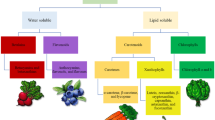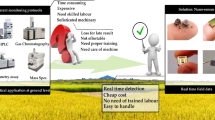Abstract
Chlorpyrifos is a type of organophosphate insecticide used extensively in the plantation of tomatoes, a worldwide popular food. However, chlorpyrifos residues on tomatoes bring risks to human health considering the consumption level of tomato is relatively high across many countries. Accurate detection and strict regulation of chlorpyrifos residues are very important in controlling health risks related to chlorpyrifos. Therefore, we developed a rapid, highly sensitive, economical, and nondestructive surface-enhanced Raman spectroscopy (SERS)-based method that can quantitatively determine the content of chlorpyrifos in tomatoes. Silver colloid was optimized and used as the enhance substrate for SERS. Chlorpyrifos residues on tomato surface and in tomato extract were both measured with SERS, and the results acquired under these practical conditions well matched those of chlorpyrifos standard solutions. Linear relationships between chlorpyrifos concentrations and SERS intensities at crucial characteristic peaks under both conditions were established, and the results showed linearity across the entire measured range from 10−3 to 10−9 mol L−1. The detection limit of the proposed method was 10−9 mol L−1, which was much lower than the standards of chlorpyrifos use for China, Japan and EU, and was the lowest reported concentration chlorpyrifos had been measured on any fruit/vegetable surface or in its extract. The proposed method was very promising in the accurate, quantitative detection of pesticide residues, and it may be adapted to a variety of agricultural products and other areas in food science.














Similar content being viewed by others
References
Pinho GPd, Neves AA, Queiroz MELRd, Silvério FO (2010) Pesticide determination in tomatoes by solid–liquid extraction with purification at low temperature and gas chromatography. Food Chem 121(1):251–256. https://doi.org/10.1016/j.foodchem.2009.11.080
Salamzadeh J, Shakoori A, Moradi V (2018) Occurrence of multiclass pesticide residues in tomato samples collected from different markets of Iran. J Environ Health Sci Eng 16(1):55–63. https://doi.org/10.1007/s40201-018-0296-4
Fantke P, Charles R, de Alencastro LF, Friedrich R, Jolliet O (2011) Plant uptake of pesticides and human health: dynamic modeling of residues in wheat and ingestion intake. Chemosphere 85(10):1639–1647. https://doi.org/10.1016/j.chemosphere.2011.08.030
Garcia SJ, Seidler FJ, Slotkin TA (2005) Developmental neurotoxicity of chlorpyrifos: targeting glial cells. Environ Toxicol Pharmacol 19(3):455–461. https://doi.org/10.1016/j.etap.2004.12.007
Randhawa MA, Anjum FM, Ahmed A, Randhawa MS (2007) Field incurred chlorpyrifos and 3,5,6-trichloro-2-pyridinol residues in fresh and processed vegetables. Food Chem 103(3):1016–1023. https://doi.org/10.1016/j.foodchem.2006.10.001
Burke RD, Todd SW, Lumsden E, Mullins RJ, Mamczarz J, Fawcett WP, Gullapalli RP, Randall WR, Pereira EFR, Albuquerque EX (2017) Developmental neurotoxicity of the organophosphorus insecticide chlorpyrifos: from clinical findings to preclinical models and potential mechanisms. J Neurochem 142(Suppl 2):162–177. https://doi.org/10.1111/jnc.14077
Grand View Research (2014) Chlorpyrifos market analysis ms, application analysis, regional outlook, competitive strategies, and forecasts, 2015 to 2022. http://www.grandviewresearch.com/industry-analysis/chlorpyrifos-market. Accessed 15 Sept 2019
Eaton DL, Daroff RB, Autrup H, Bridges J, Buffler P, Costa LG, Coyle J, McKhann G, Mobley WC, Nadel L, Neubert D, Schulte-Hermann R, Spencer PS (2008) Review of the toxicology of chlorpyrifos with an emphasis on human exposure and neurodevelopment. Crit Rev Toxicol 38(Suppl 2):1–125. https://doi.org/10.1080/10408440802272158
Meeker JD, Ryan L, Barr DB, Herrick RF, Bennett DH, Bravo R, Hauser R (2004) The relationship of urinary metabolites of carbaryl/naphthalene and chlorpyrifos with human semen quality. Environ Health Perspect 112(17):1665–1670. https://doi.org/10.1289/ehp.7234
Sparling DW, Fellers G (2007) Comparative toxicity of chlorpyrifos, diazinon, malathion and their oxon derivatives to larval Rana boylii. Environ Pollut 147(3):535–539. https://doi.org/10.1016/j.envpol.2006.10.036
Rauh VA, Garfinkel R, Perera FP, Andrews HF, Hoepner L, Barr DB, Whitehead R, Tang D, Whyatt RW (2006) Impact of prenatal chlorpyrifos exposure on neurodevelopment in the first 3 years of life among inner-city children. Pediatrics 118(6):e1845–e1859. https://doi.org/10.1542/peds.2006-0338
Beale DJ, Kaserzon SL, Porter NA, Roddick FA, Carpenter PD (2010) Detection of s-triazine pesticides in natural waters by modified large-volume direct injection HPLC. Talanta 82(2):668–674. https://doi.org/10.1016/j.talanta.2010.05.030
Peng G, Lu Y, He Q, Mmereki D, Zhou G, Chen J, Tang X (2015) Determination of 3,5,6-trichloro-2-pyridinol, phoxim and chlorpyrifos-methyl in water samples using a new pretreatment method coupled with high-performance liquid chromatography. J Sep Sci 38(24):4204–4210. https://doi.org/10.1002/jssc.201500736
Sinha SN, Pal R, Dewan A, Mansuri MM, Saiyed HN (2006) Effect of dissociation energy on ion formation and sensitivity of an analytical method for determination of chlorpyrifos in human blood, using gas chromatography–mass spectrometer (GC–MS in MS/MS). Int J Mass Spectrom 253(1–2):48–57. https://doi.org/10.1016/j.ijms.2006.02.020
Espana Amortegui JC, Guerrero Dallos JA (2015) Practical aspects in gas chromatography-mass spectrometry for the analysis of pesticide residues in exotic fruits. Food Chem 182:14–22. https://doi.org/10.1016/j.foodchem.2015.02.113
Rissato S, Galhiane M, Dealmeida M, Gerenutti M, Apon B (2007) Multiresidue determination of pesticides in honey samples by gas chromatography–mass spectrometry and application in environmental contamination. Food Chem 101(4):1719–1726. https://doi.org/10.1016/j.foodchem.2005.10.034
Salm P, Taylor PJ, Roberts D, de Silva J (2009) Liquid chromatography-tandem mass spectrometry method for the simultaneous quantitative determination of the organophosphorus pesticides dimethoate, fenthion, diazinon and chlorpyrifos in human blood. J Chromatogr B Analyt Technol Biomed Life Sci 877(5–6):568–574. https://doi.org/10.1016/j.jchromb.2008.12.066
Kuswandi B, Fikriyah CI, Gani AA (2008) An optical fiber biosensor for chlorpyrifos using a single sol–gel film containing acetylcholinesterase and bromothymol blue. Talanta 74(4):613–618. https://doi.org/10.1016/j.talanta.2007.06.042
Gabaldon JA, Maquieira A, Puchades R (2007) Development of a simple extraction procedure for chlorpyrifos determination in food samples by immunoassay. Talanta 71(3):1001–1010. https://doi.org/10.1016/j.talanta.2006.04.041
Stoilova NA, Surleva AR, Stoev G (2012) Simultaneous determination of nine quinolones in food by liquid chromatography with fluorescence detection. Food Anal Methods 6(3):803–813. https://doi.org/10.1007/s12161-012-9488-1
Armenta S, Quintas G, Garrigues S, Delaguardia M (2005) Mid-infrared and Raman spectrometry for quality control of pesticide formulations. TrAC Trends Anal Chem 24(8):772–781. https://doi.org/10.1016/j.trac.2005.03.017
Zheng J, He L (2014) Surface-enhanced raman spectroscopy for the chemical analysis of food. Compr Rev Food Sci Food Saf 13(3):317–328. https://doi.org/10.1111/1541-4337.12062
Stiles PL, Dieringer JA, Shah NC, Van Duyne RP (2008) Surface-enhanced Raman spectroscopy. Annu Rev Anal Chem 1(1):601–626. https://doi.org/10.1146/annurev.anchem.1.031207.112814
Kudelski A (2008) Analytical applications of Raman spectroscopy. Talanta 76(1):1–8. https://doi.org/10.1016/j.talanta.2008.02.042
El-Diasty F (2011) Coherent anti-Stokes Raman scattering: spectroscopy and microscopy. Vib Spectrosc 55(1):1–37. https://doi.org/10.1016/j.vibspec.2010.09.008
Liu B, Han G, Zhang Z, Liu R, Jiang C, Wang S, Han MY (2012) Shell thickness-dependent Raman enhancement for rapid identification and detection of pesticide residues at fruit peels. Anal Chem 84(1):255–261. https://doi.org/10.1021/ac202452t
Zhu G, Hu Y, Gao J, Zhong L (2011) Highly sensitive detection of clenbuterol using competitive surface-enhanced Raman scattering immunoassay. Anal Chim Acta 697(1–2):61–66. https://doi.org/10.1016/j.aca.2011.04.031
Jiang J, Zhu L, Zou J, Ou-yang L, Zheng A, Tang H (2015) Micro/nano-structured graphitic carbon nitride–Ag nanoparticle hybrids as surface-enhanced Raman scattering substrates with much improved long-term stability. Carbon 87:193–205. https://doi.org/10.1016/j.carbon.2015.02.025
Fan Y, Lai K, Rasco BA, Huang Y (2014) Analyses of phosmet residues in apples with surface-enhanced Raman spectroscopy. Food Control 37(1):153–157
Yaseen T, Sun D-W, Pu H, Pan T-T (2018) Detection of omethoate residues in peach with surface-enhanced Raman spectroscopy. Food Anal Methods 11(9):2518–2527. https://doi.org/10.1007/s12161-018-1233-y
Müller C, David L, Chiş V, Pînzaru SC (2014) Detection of thiabendazole applied on citrus fruits and bananas using surface enhanced Raman scattering. Food Chem 145(7):814–820
Fang H, Zhang X, Zhang SJ, Liu L, Zhao YM, Xu HJ (2015) Ultrasensitive and quantitative detection of paraquat on fruits skins via surface-enhanced Raman spectroscopy. Sens Actuators B Chem 213:452–456
Fan Y, Lai K, Rasco BA, Huang Y (2015) Determination of carbaryl pesticide in Fuji apples using surface-enhanced Raman spectroscopy coupled with multivariate analysis. LWT Food Sci Technol 60(1):352–357
Feng S, Hu Y, Ma L, Lu X (2017) Development of molecularly imprinted polymers-surface-enhanced Raman spectroscopy/colorimetric dual sensor for determination of chlorpyrifos in apple juice. Sens Actuators B Chem 241:750–757. https://doi.org/10.1016/j.snb.2016.10.131
Lee PC, Meisel D (1982) Adsorption and surface-enhanced Raman of dyes on silver and gold sols. J Phys Chem 86(17):3391–3395. https://doi.org/10.1021/j100214a025
Zhu Q, Li H, Lu F, Chai Y, Yuan Y (2016) A widely applicable silver sol for TLC detection with rich and stable SERS features. Nanoscale Res Lett 11(1):220. https://doi.org/10.1186/s11671-016-1442-5
Luo H, Huang Y, Lai K, Rasco BA, Fan Y (2016) Surface-enhanced Raman spectroscopy coupled with gold nanoparticles for rapid detection of phosmet and thiabendazole residues in apples. Food Control 68:229–235
Sacré PY, Bleye CD, Chavez PF, Netchacovitch L, Hubert P, Ziemons E (2014) Data processing of vibrational chemical imaging for pharmaceutical applications. J Pharm Biomed Anal 101:123–140
Bussian B, Härdle W (1984) Robust smoothing applied to white noise and single outlier contaminated Raman spectra. Appl Spectros 38(3):309–313
Vo-Dinh T, Wu W, Lieberman RA, Hu M, Ou FS, Gauglitz G, Williams RS, Li Z (2010) Rational engineering of highly sensitive SERS substrate based on nanocone structures. Adv Environ Chem Biol Sens Technol 7673:76730O. https://doi.org/10.1117/12.849959
Xu Q, Guo X, Xu L, Ying Y, Wu Y, Wen Y, Yang H (2017) Template-free synthesis of SERS-active gold nanopopcorn for rapid detection of chlorpyrifos residues. Sens Actuators B Chem 241:1008–1013. https://doi.org/10.1016/j.snb.2016.11.021
Liu Y, Zhang Y, Wang H, He B (2015) Quantitative detection of pesticides based on SERS and gold colloid. In: International conference on computer and computing technologies in agriculture. Springer, Cham, pp 587–596
Sharma S, Uttam R, Bharti AS, Shukla N, Uttam KN (2019) Label-free mapping of the biochemicals in tomato fruit by confocal Raman microspectroscopy. Natl Acad Sci Lett 42(4):365–368. https://doi.org/10.1007/s40009-018-0747-6
Trebolazabala J, Maguregui M, Morillas H, de Diego A, Madariaga JM (2013) Use of portable devices and confocal Raman spectrometers at different wavelength to obtain the spectral information of the main organic components in tomato (Solanum lycopersicum) fruits. Spectrochim Acta A Mol Biomol Spectrosc 105:391–399. https://doi.org/10.1016/j.saa.2012.12.047
Qin J, Chao K, Kim MS (2012) Nondestructive evaluation of internal maturity of tomatoes using spatially offset Raman spectroscopy. Postharvest Biol Technol 71:21–31. https://doi.org/10.1016/j.postharvbio.2012.04.008
Luo H, Wang X, Huan Y, Lai K, Rasco BA, Fan Y (2018) Rapid and sensitive surface-enhanced Raman spectroscopy (SERS) method combined with gold nanoparticles for determination of paraquat in apple juice. J Sci Food Agric 98:3892–3898
Huang F, Li Y, Guo H, Xu J, Chen Z, Zhang J, Wang Y (2016) Identification of waste cooking oil and vegetable oil via Raman spectroscopy. J Raman Spectrosc 47(7):860–864
Thermo Fisher Scientific. Routine quantitative method of analysis for pesticides using GC Orbitrap mass spectrometry in accordance with SANTE/11945/2015 guidelines. https://www.thermofisher.com/document-connect/document-connect.html?url=https%3A%2F%2Fassets.thermofisher.com%2FTFS-Assets%2FCMD%2FApplication-Notes%2FAN-10509-GC-MS-Pescitides-SANTE-11945-2015-AN10509-EN.pdf&title=QXBwbGljYXRpb24gTm90ZTogUm91dGluZSBRdWFudGl0YXRpdmUgTWV0aG9kIG9mIEFuYWx5c2lzIGZvciBQZXN0aWNpZGVzIHVzaW5nIEdDIE9yYml0cmFwIE1hc3MgU3BlY3Ryb21ldHJ5IGluIGFjY29yZGFuY2Ugd2l0aCBTQU5URS8xMTk0NS8yMDE1IEd1aWRlbGluZXM=. Accessed 15 Sept 2019
Safi JM, Abou-Foul NS, El-Nahhal YZ, El-Sebae AH (2002) Monitoring of pesticide residues on cucumber, tomatoes and strawberries in Gaza Governorates, Palestine. Mol Nutr Food Res 46(1):34–39
Nascimento MM, da Rocha GO, de Andrade JB (2018) A rapid low-consuming solvent extraction procedure for simultaneous determination of 34 multiclass pesticides associated to respirable atmospheric particulate matter (PM2.5) by GC–MS. Microchem J 139:424–436. https://doi.org/10.1016/j.microc.2018.03.023
Acknowledgements
This research was supported by the Shanghai Pujiang Program (No. 18PJ1408700), National Key R&D Program of China (No. 2017YFC0110200), National Natural Science Foundation of China (NSFC, No. 61805143), Shanghai Sailing Program (No. 19YF1435400).
Author information
Authors and Affiliations
Corresponding author
Ethics declarations
Conflict of interest
The authors declare no conflict of interest.
Compliance with ethics requirements
This study does not contain human or animal subjects.
Additional information
Publisher's Note
Springer Nature remains neutral with regard to jurisdictional claims in published maps and institutional affiliations.
Electronic supplementary material
Below is the link to the electronic supplementary material.
Rights and permissions
About this article
Cite this article
Ma, P., Wang, L., Xu, L. et al. Rapid quantitative determination of chlorpyrifos pesticide residues in tomatoes by surface-enhanced Raman spectroscopy. Eur Food Res Technol 246, 239–251 (2020). https://doi.org/10.1007/s00217-019-03408-8
Received:
Revised:
Accepted:
Published:
Issue Date:
DOI: https://doi.org/10.1007/s00217-019-03408-8




